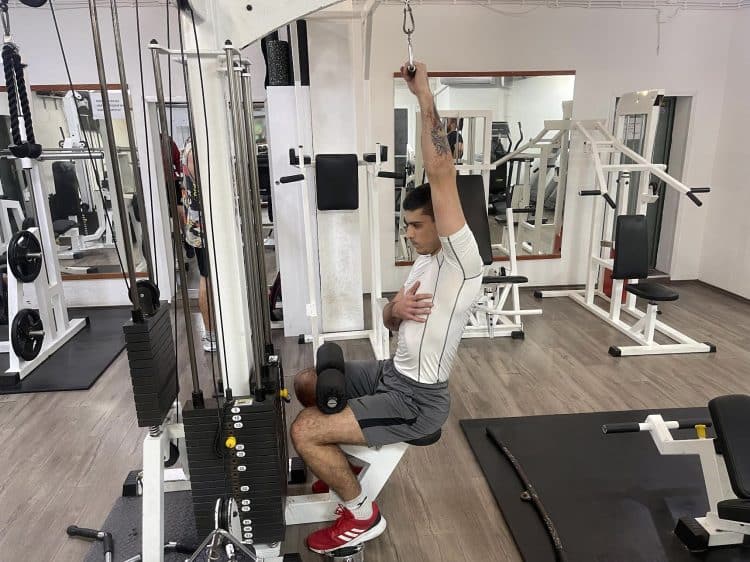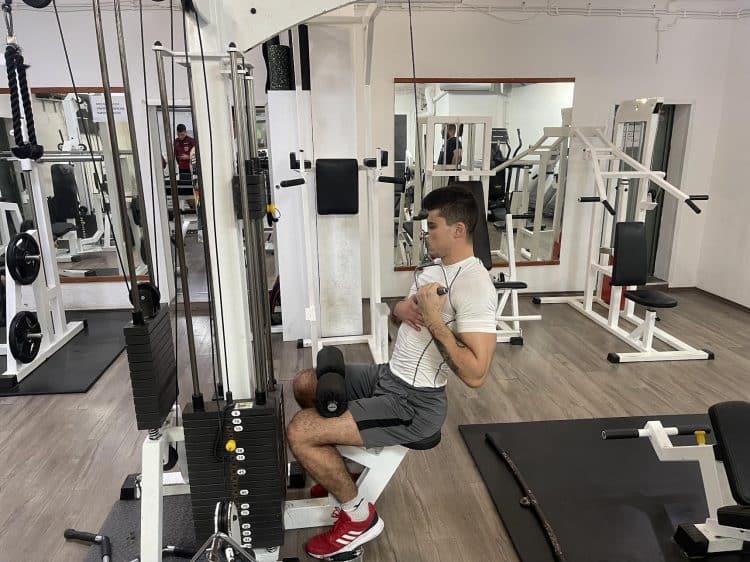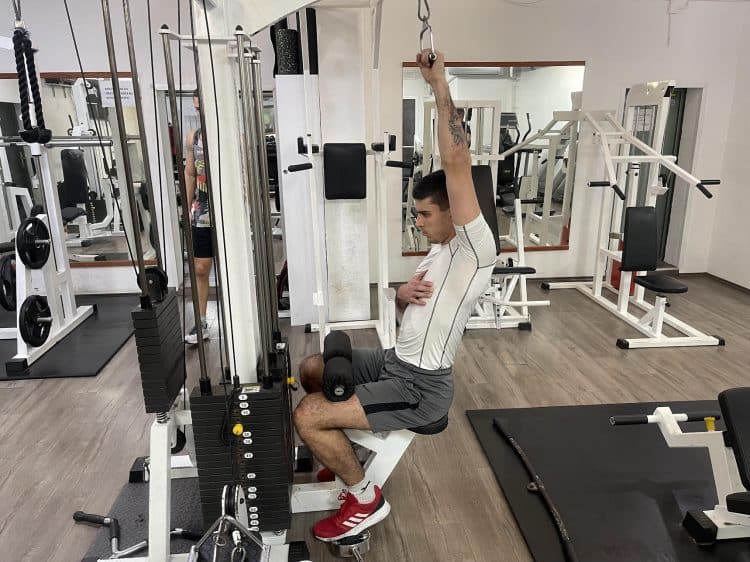The single-arm lat pulldown is a unilateral exercise following the vertical pull movement pattern. While bodyweight pull-ups and conventional bilateral lat pulldowns are excellent lifts, adding unilateral movements to your training regimen can help take your gains to the next level.
A study published in the Biology of Sport showed that unilateral exercises increase one’s ability to generate maximal strength than bilateral exercises. (1)
Basically, if you perform a bilateral squat and then perform a single-leg squat with both legs, you would generate more force when adding two single-leg squats compared to the traditional bilateral squat.
This is called a bilateral deficit, a phenomenon proving that maximal voluntary force generated through bilateral contractions is less than the sum of the strength of your right and left limbs when contracting independently. (2)
That was a lot for the introduction part.
Why don’t we jump right into single-arm lat pulldowns and how to perform them correctly?
Level Up Your Fitness: Join our 💪 strong community in Fitness Volt Newsletter. Get daily inspiration, expert-backed workouts, nutrition tips, the latest in strength sports, and the support you need to reach your goals. Subscribe for free!
How To Perform a Single-Arm Lat Pulldown: Step-By-Step Guide
Below is a guide on performing single-arm lat pulldowns correctly to avoid injuries and maximize your lifting performance.
Step One — Assume the Starting Position
Attach a D-handle attachment to the lat pulldown pulley. Grab the handle with an overhand grip. Sit on the machine’s bench and secure your thighs under the leg pads. Place your other hand on the thigh pad, chest, or hip.

Pro Tip: Protract and depress your shoulder blades (scapula) to assume an active pulling position.
Step Two — Pull the Handle Towards Your Body
While breathing out, pull the handle towards your upper chest by flexing your elbow. The handle should be beside your shoulder at the bottom of the range of motion. Pause at the isometric contraction point at the bottom. Avoid leaning back while performing this exercise.

Pro Tip: Use the abdominal breathing technique by forcefully exhaling from your stomach as you pull the handle down. This will enable you to generate more force and build strength and power along the way.
Step Three — Slow Eccentrics
Return to the starting position by extending your elbow overhead. Follow a slow and controlled motion to avoid injuries and ensure better mind-muscle connection and muscle contractions.

Pro Tip: Focus on your lats during the eccentric phase and aim to return the handle to the starting position as slowly as possible.
Muscles Targeted By Single-Arm Lat Pulldowns
Here are the primary muscles targeted:
- Latissimus dorsi
- Biceps brachii
Also, here are the supporting or secondary muscles working during unilateral lat pulldowns:
- Rear deltoids
- Trapezius
- Rhomboids
- Teres major
- Brachialis and brachioradialis
Benefits of Single-Arm Lat Pulldowns
Here are the benefits of performing unilateral lat pulldowns:
Improved Muscle Isolation
Unilateral or single-arm lat pulldowns are excellent for isolating one side of your lats and biceps. While this can help bias hypertrophy, it also has numerous benefits, such as improving the overall stability of the working side.
This also ties beautifully with the next benefit on my list: correcting muscle imbalances with unilateral exercises.
Correction of Strength Imbalances
As taught in applied kinesiology classes, unilateral exercises are the bedrock of correcting muscle imbalances. For example, single-arm lat pulldowns are extremely beneficial for all those individuals experiencing functional thoracic scoliosis.
While you are stretching the opposite side of where the scoliotic curve is located, you can easily perform a lat pulldown with your other hand to strengthen those muscles around the shoulder blade, which are necessary for keeping the spine in line and in a neutral position.
Increased Range of Motion
Most of the time, you can’t perform the full range of motion for certain exercises because of limiting factors such as joint angle and type of equipment. This is where unilateral exercises become so useful that you must include them in your weekly workouts.
Unilateral exercises such as the single-arm lat pulldowns allow you to increase your working range of motion. Consequently, this builds strength through the whole range of motion, which is especially useful for preventing injuries and avoiding muscle and strength imbalances.
Enhanced Core Engagement
In my opinion, core engagement is one of the key advantages of unilateral exercises like single-arm lat pulldowns. This is excellent for teaching your body how to stabilize effectively and prevent movement when necessary. By building your core strength, you effectively reduce the chance of injury.
Level Up Your Fitness: Join our 💪 strong community in Fitness Volt Newsletter. Get daily inspiration, expert-backed workouts, nutrition tips, the latest in strength sports, and the support you need to reach your goals. Subscribe for free!
Variability in Training
Workout and exercise versatility are important. Not just to avoid the sheer monotony of everyday workouts but because exercise versatility and variety can help improve endurance, hypertrophy, strength, and power. There was a saying during my freshmen college years that my professor constantly kept repeating:
“Strength loves diversity.”
To build strength, you must lift heavy with intention and diversify your workouts.
Best Single-Arm Lat Pulldown Variations and Alternatives
The best single-arm lat pulldown variations and alternatives include standing single-arm cable lat pulldowns, single-arm resistance band lat pulldowns, dumbbell pullovers, and bilateral lat pulldowns.
Let’s tackle all these below.
Standing Single-Arm Cable Lat Pulldown
The standing single-arm cable lat pulldown is a more functional variation of sitting single-arm lat pulldowns.
This is because you must be in the athletic stance, which is more unstable than sitting on the lat pulldown machine. I believe this is the best unilateral pull exercise variation that all types of athletes must utilize to prevent injuries, build stronger core and stability, and maximize performance on the field.
Steps:
- Assume a standing position in front of the cable machine.
- Set the cable pulley to the highest position.
- Hold the handle with your right hand and position yourself at a distance from the cable machine that aligns the cable’s trajectory more vertically rather than diagonally.
- I advise assuming a split stance for added stability.
- Start the exercise by pulling the handle towards the right side of your body.
- When you reach the end range of motion, hold that position for one second.
- Return the handle to the starting position by performing slow eccentrics.
- Repeat for the desired amount of reps before switching sides.
Pro Tip: Squeeze and retract the shoulder blade of the working side to maximize muscle contraction.
Single-Arm Resistance Band Lat Pulldown
Single-arm resistance band lat pulldowns are a great alternative for a few reasons. The most important one is that they provide progressive tension during concentrics.
Why is this important, you may ask?
Well, the closer you move to the end range of motion during the concentric phase, the easier it gets.
However, while using resistance bands, the more you pull/push toward the end range of motion, the harder it gets. This way, you can overcome greater force and challenge your muscles more when they are usually almost “relaxed” or inactive.
Steps:
- Attach the resistance band on a high squat rack pole or on the pull-up bar that is high enough.
- Grab the band with your right hand. Pull on the band slightly so it is taut, and you feel a slight tension in your muscles. If that’s impossible because of your height, feel free to transition to the half-kneeling position.
- Start the exercise by pulling the band towards your right shoulder.
- When you reach the end range of motion, hold that position for one second.
- Reverse the motion by extending the band over your head to return to the starting position.
- Repeat for the desired number of reps before switching sides.
Pro Tip: To build explosive strength, perform the concentric or pulling movement as fast as possible while exhaling from your abdominal area.
Dumbbell Pullover
I like to include dumbbell pullovers in my workouts as a finisher. I found them to be most helpful hypertrophy-wise in this scenario, but feel free to experiment and try it yourself.
Steps:
- Pick the dumbbell of appropriate weight and lie on the flat bench.
- Extend the dumbbell above your chest.
- Start the exercise by flexing your shoulders and moving the dumbbell behind your head towards the floor.
- Hold that position for one second when you reach maximal shoulder flexion while also making sure your lumbar spine isn’t excessively tilted to form lumbar lordosis.
- Reverse the motion to return the dumbbell to the starting position.
- Repeat for the desired number of reps.
Pro Tip: Focus on maintaining a slight bend in your elbows throughout the movement to protect your joints and ensure the tension stays on your lats and chest.
Bilateral Lat Pulldown
These are the conventional lat pulldowns. These are great for back hypertrophy and strength and can be used with regular bodyweight pull-ups to build strength in the vertical pulling movement pattern.
Steps:
- Load the machine with sufficient weight and sit on the machine.
- Grab the bar with an overhand grip, just a little outside shoulder width.
- Start the exercise by pulling the bar towards your collarbone.
- When you reach the end range of motion, hold that position for one second.
- Reverse the motion by abducting your shoulders and extending your elbows to return the bar to the starting position.
- Repeat for the desired number of reps.
Pro Tip: Squeeze your shoulder blades at the bottom for a better mind-muscle connection.
FAQs
Is single-arm lat pulldown effective?
Absolutely, single-arm lat pulldowns are effective for numerous reasons. First, they are excellent at correcting muscle imbalances. Second, they are great for building core stability and strength. Third, they are more functional since they imitate real-life situations and movements.
Is the single-arm lat pulldown a compound movement?
The single-arm lat pulldown is a compound movement involving multiple joints working simultaneously to execute the movement.
Which pulldown variation is the best for lat development?
The best variation will depend on your training objectives. Employ wide-grip lat pulldowns to build wider lats. Conversely, I would advise close-grip pulldown variations if you want to bias back thickness.
How do I activate lats during pulldown?
You can activate your lats more during the pulldown motion by consciously thinking about your lats while you perform the movement. Pro tip — Wrap your pinky finger around the bar forcefully while performing this exercise, as it helps with better lat activation.
When should I breathe during a lat pulldown?
Breathe out during the concentric phase concentric phase. On the flip side, you should breathe in during the eccentric phase.
Wrapping Up
Single-arm lat pulldowns are a great vertical pulling exercise for developing unilateral strength and power. However, they are also useful for correcting muscle imbalances and improving stability by activating your core musculature.
I believe every lifter should incorporate unilateral exercises such as single-arm lat pulldowns into their workout sessions to boost strength and hypertrophy and reduce the chance of injuries. In the comments below, let me know how you implement single-arm lat pulldowns into your workouts.
References
- Costa E, Moreira A, Cavalcanti B, Krinski K, Aoki M. Effect of unilateral and bilateral resistance exercise on maximal voluntary strength, total volume of load lifted, and perceptual and metabolic responses. Biol Sport. 2015;32(1):35-40. doi:10.5604/20831862.1126326
- Škarabot J, Cronin N, Strojnik V, Avela J. Bilateral deficit in maximal force production. Eur J Appl Physiol. 2016;116(11-12):2057-2084. doi:10.1007/s00421-016-3458-z
Relevant Articles:
- Wide-Grip Lat Pull-down (Lats) | Exercise Guides and Videos
- The 8 Best Old-School Lat Exercises
- The Best Latissimus Dorsi Exercises to Build Bigger Lats
Interested in measuring your progress? Check out our strength standards for Dumbbell Pullover, Pull Ups, Squat, and more.








